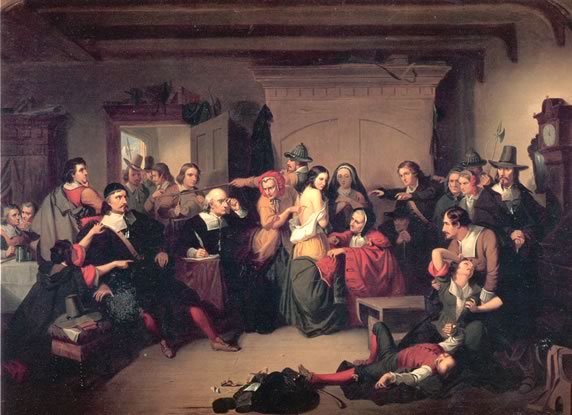Why would adults in Salem, Massachusetts in the 1690s take the accusations of nine year old girls seriously? During the seventeenth century, New England had grown diverse. The people living in the communities were of different backgrounds. But in the 1690’s there was an apparent outbreak of witchcraft. The most famous of these outbreaks was the event in Salem, Massachusetts in 1692 that stirred up the Salem community and soon spread to other communities.
The widespread hysteria over witches was all over the town after an accusation of witchcraft was made in January 1692. A group of young adolescent girls met in the home of Samuel Parris, a Puritan pastor in Salem. The pastor had a nine year old daughter, Betty. Betty and her cousin Abigail were fascinated by the voodoo tales and tricks told to them by the family slave. The family slave, Tituba, was the one whom the little girls had sought after for entertainment.1 It was not long after their time spent with Tituba, when the girls began to behave strangely; seeing visions, babbling at times, and lapsing into trances. The Puritans thought that these behaviors were of witchcraft, as the work of the devil. People in Salem began believing the girls, and charged Tituba and two other village women for practicing witchcraft on them. Two men, John Hathorne and Johnathan Corwin of Massachusetts, were called to do a legal examination of the women. The Puritans followed the Old Testament law. This was how they assessed the examinations. Scripture had a statement that said witches were not able to live. The two men knew exactly what they had to do. The examination was done on these women of Salem by looking for a certain mark on the body: a wart or tit. This specific mark was said to be the place where the devil and his demons would take blood out of the witch.2 Many of the women accused were of lower status in the community.

Research shows most of the accused witches were middle-aged women, widowed, with few or no children. Also, if the woman had been involved with domestic conflicts, they were accused. The women were accused of crimes and appeared to be dangerous by their neighbors. Women in Salem who inherited or possessed land were also accused of witchcraft.3 The accusations towards these women were out of the ordinary and seemingly wrong. One must first think about the view of women during this time. They were undermined and portrayed as having no power or knowledge of such things; they were subservient to the men in the community. Not only were low class women accused of witchcraft, but as time passed, superior women were accused as well.4
On October 29th, the Salem Witch Trials were called to an end. Governor Phips dismissed the Court and that marked the end to the witch hunt craze. Many were disappointed about the ending of the trials, but many were glad to return to work.5 The community in Salem blamed Pastor Parris for letting the innocent die. The people of the Salem church also voted to void his salary. In the following years, those family members of the deceased were restored their good names. The families were awarded a compensation for all the financial loses they went through during such tragic times. Increase Mather, a pastor of the Boston Puritan Church, wanted the people to do away with the court because he believed they put innocent people to death.
The Witch trials took on an important role in American History. The trials became a tragic and memorable moment in history. Generational, racial, and sexual hostility, opposition to law, social stresses, and food poisoning were all causes as to why the people had anxieties that found release in the witch hunt craze. The witch hunts became searches for scapegoats; the community leaders were looking for anyway possible to ease the community’s anxieties.6
- Kenneth P. Minkema, “In the Devil’s Snare: The Salem Witchcraft Crisis of 1692,” The Christian Century, no. 8 (2003): 37. ↵
- Salem Press Encyclopedia, January 2015, s.v. “Salem Witchcraft Trials,” by Warren M. Billings and Kimberly Manning. ↵
- Alan Brinkley, American History, 15th ed., vol. 1: to 1865 (2 Penn Plaza, New York, NY 10121: McGraw Hill Education, 2015), 86-87. ↵
- Salem Press Encyclopedia, January 2015 s.v. “Salem Witchcraft Trials,” by Warren M. Billings, Kimberly Manning. ↵
- Salem Press Encyclopedia, January 2015 s.v. “Salem Witchcraft Trials,” by Warren M. Billings, Kimberly Manning. ↵
- Salem Press Encyclopedia, January 2015 s.v. “Salem Witchcraft Trials,” by Warren M. Billings and Kimberly Manning. ↵



178 comments
Erik Rodriguez
I found this article mind boggling! I didn’t know that these accusations were made by nine-year-old girls; I always thought that they were made by older, educated women and men. I wonder if men would ever accuse their wives to get rid of them. It makes no sense to me that these accusations were ever believed. But it does make me wonder, were there any real witches along with those who were accused?
Over all this article makes me want to learn more about Salem and possibly visit to learn more about the trials.
Very interesting and well written!
Keep up the good work!
Angelica Espinoza
Great topic! And one that I’ve discussed a lot.. haha. My last history class there were several people who chose to do presentations on the Witch Trials and the different takes on what occurred is quite fascinating to listen to. I found myself wondering how the entire town took those young girls’ word as solid evidence. It is something very interesting indeed. Nice job! Also the compensation for lost ones was almost like an, “oopsie, we messed up but this should make it better” it seems and I’m not sure how I feel about that, but very intriguing idea to explore.
George Manzanares
Nicely done! I truly enjoyed how you illustrated the many facets of reasons for the behavior that occurred during the Salem Witch Trials. Researchers have continued to investigate the many possibilities for such behavior. The many reasons include health, religion, personal vendettas, etc. We will never truly understand for sure what the reasons are for sure. However, it is interesting to explore the very many possibilities!
Karissa Aguilar
It is really crazy that a woman who was ill or had health problems would be accused of being witches and it truly is a tragedy that women were killed over these speculations. I love how the perspective of this article remains consistent and holds the tone of tragedy.
Bryce Cardwell
This topic in U.S. History is one of the most interesting and mind boggling topics I have looked into. The experiences the town went through during the Salem Witch Trials is unexplainable. Their are many opinions on how and why the belief in witches rose in the town, but a distinct answer is yet to be found. The fact that two little girls caused such disruption and murder blows my mind. Maybe it was a ploy to erase the lower class and those members that were wealthy but not needed?
Priscilla Reyes
The Salem witch trials are a very interesting event in history and definitely worthy of an article. The “outbreak of witchcraft,” I believe, was not a battle between evil spirits but between cultures. Also, the women were attacked and blamed for the horrible things going on. The female gender, women of color, and people of the lower class such as slaves were convicted. As you stated, the community was going through mixed feelings and anxieties at the time and the Salem witch trials were a distraction from all of that.
Mariana Sandoval
I’m glad that you included information about the aftermath of the Salem Witch Trials (like the people being unhappy with the pastor and that the families affected by the trials did not live the rest of their lives with a stigma attached to their name). Another classmate did an article on how America was hysteric and freaking out over a radio prank that involved reading War of the Worlds and how they thought aliens were actually invading the planet. I think it’s interesting to read about the superstitious things America believed in throughout history, but this incident is a more serious, hysterical response to susperstitious accusations as many people unfortunately died.
Rachel White
Your first sentence is a question I have asked myself countless times while reading about the Salem Witch Trials. The points you brought up in your article were very interesting, including the aspect of gender, social, religious and racial issues associated with the trials. Also, I found it darkly humorous that the families were compensated for their losses. You cannot throw money at the issue and make a person rise from the dead. I enjoyed this article a lot and the topic itself is one that fascinates me. Great work!
Jezel Luna
I was really fascinated about the different points you brought to my attention. I have very little background knowledge on the subject. You were not only able to inform me on this subject but lured me in with different facts. I found it very striking that these so called “witches” had the marking of the devil/demons as either a tit or wart. I was unaware that families were reimbursed for their loved ones that they lost. This article was very informative and written in a sequence, so I was able to follow along smoothly. Keep up the great work!!
Danielle Garza
The Salem witch trials had a profound effect in America and this captured truly how unsure it was. There was no bases of evidence and as you pointed out the women were being targeted for what little power they had. This article had shed light on the problems of this community and the movement in general. Outstanding article.